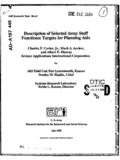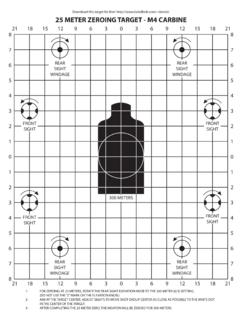Transcription of Europe 2020 Targets (Updated on 07/03/2017)
1 Europe 2020 Targets ( updated on 07/03/2017) EU/Member State Employment rate Gross domestic expenditure on research and development Greenhouse gas emissions Share of renewable energy Energy efficiency Early leavers from education and training Tertiary educational attainment Poverty and social exclusion EU-28 Increasing the employment rate of the population aged 20-64 to at least 75% Increasing combined public and private investment in R&D to 3% of GDP Reducing greenhouse gas emissions by at least 20% compared to 1990 levels Increasing the share of renewable energy in final energy consumption to 20%, Moving towards a 20% increase in energy efficiency (equalling a reduction to 1 483 Mtoe of primary energy consumption) Reducing school drop-out rates to less than 10% (of the population aged 18 to 24) Increasing the share of the population aged 30-34 having completed tertiary education to at least 40% Lifting at least 20 million people out of the risk of poverty and social exclusion (compared to 2008)* Belgium % 3 % - 15 % 13 % % 47 % - 380 000 persons Bulgaria 76 % % + 20 % 16 % 11 % 36 % Reduce by 260 000 the number of persons living in monetary poverty Czech Republic 75 % 1 % (public sector only) + 9 % 13 % % 32 % - 100 000 persons Denmark 80 % 3 % - 20 % 30 % 10 % > 40 % Reduce by 22 000 the number of persons living in households with very low work intensity Germany 77 % 3 % - 14 % 18 % < 10 % 42 % (ISCED 2011 level 4-8) Reduce by 20 % the number of long-term unemployed (unemployed for more than one year) compared to 2008.
2 (equalling to a reduction of 320 000 longterm unemployed persons) Estonia 76 % 3 % + 11 % 25 % % 40 % Reduce to a rate of 15 % the number of persons living at risk of poverty after social transfers (compared to % in 2010) Ireland 69 - 71 % % of GNP (Approximately 2 % of GDP) - 20% 16 % 8 % 60 % Reduce by a minimum of 200 000 the population in combined poverty (either consistent poverty, at-risk-of-poverty or basic deprivation). Greece 70 % % - 4 % 18 % <10 % 32 % - 450 000 persons Spain 74 % 2 % - 10 % 20 % 15 % 44 % - 1 400 000 to - 1 500 000 persons France 75 % 3 % - 14 % 23 % % 50 % (age group 17 to 33) - 1 900 000 persons (compared to 2007) Croatia % % + 11 % 20 % 4 % 35 % Reduce to 1 220 000 the number of persons at risk of poverty or social exclusion . Italy 67 - 69 % % - 13 % 17 % 16 % 26 - 27 % - 2 200 000 persons EU/Member State Employment rate Gross domestic expenditure on research and development Greenhouse gas emissions Share of renewable energy Energy efficiency Early leavers from education and training Tertiary educational attainment Poverty and social exclusion Cyprus 75 - 77 % % - 5 % 13 % 10 % 46 % - 27 000 persons or reduce the rate to % of the population (compared to % in 2008)
3 Latvia 73 % % + 17 % 40 % 10 % 34 - 36 % Reduce by 121 000 the number of persons living at risk of poverty after social transfers and/or in households with very low work intensity Lithuania % % + 15 % 23 % < 9 % % - 170 000 persons and limit to 814 000 persons in 2020 Luxembourg 73 % - % - 20 % 11 % < 10 % 66 % - 6 000 persons Hungary 75 % % + 10 % 13 % 10 % 34 % - 450 000 persons Malta 70 % 2 % + 5 % 10 % 10 % 33 % - 6 560 persons Netherlands 80 % % - 16 % 14 % 8 % > 40 % Reduce by 100 000 the number of persons (aged 0-64) living in a jobless household (compared to 2008) Austria 77 % % - 16 % 34 % % 38 % - 235 000 persons Poland 71 % % + 14 % 15 % % 45 % -1 500 000 persons Portugal 75 % - % + 1 % 31 % 10 % 40 % - 200 000 persons Romania 70 % 2 % + 19 % 24 % % % - 580 000 persons Slovenia 75 % 3 % + 4 % 25 % 5 % 40 % - 40 000 persons Slovakia 72 % % + 13 % 14 % 6 % 40 % Reduce to a rate of % the number of persons living in poverty or social exclusion (compared to in 2008) Finland 78 % 4 % - 16 % 38 % 8 % 42 % (excluding former tertiary Vocational Education and Training (VET)) Reduce to 770 000 the number of persons living in poverty or social exclusion Sweden > 80 % 4 % - 17 % 49 % < 7 % 45 - 50 % Reduce to well below 14 the percentage of women and men (aged 20-64) who are not in the labour force (except full-time students)
4 , long-term unemployed or on long-term sick leave United Kingdom No target in National Reform Programme No target in National Reform Programme - 16 % 15 % No target in National Reform Programme No target in National Reform Programme No target in National Reform programme, but numerical Targets exist under the umbrella of the 2010 Child Poverty Act and the Child Poverty Strategy 2011-2014 EU/Member State Employment rate Gross domestic expenditure on research and development Greenhouse gas emissions Share of renewable energy Energy efficiency Early leavers from education and training Tertiary educational attainment Poverty and social exclusion Source of information and comments EU target as set out in European Commission. Taking stock of the Europe 2020 strategy for smart, sustainable and inclusive growth, COM(2014) 130 final, Brussels, 2014 (p. 12). National Targets as set out in the most recent National Reform Programmes. The definitions of the national Targets are comparable to the EU target.
5 EU target as set out in European Commission, Taking stock of the Europe 2020 strategy for smart, sustainable and inclusive growth, COM(2014) 130 final, Brussels, 2014 (p. 12). National Targets as set out in the most recent National Reform Programmes. The definitions of the national Targets are comparable to EU target except for Czech Republic and Ireland (see country specific remarks). EU target as set out in European Commission, Taking stock of the Europe 2020 strategy for smart, sustainable and inclusive growth, COM(2014) 130 final, Brussels, 2014 (p. 12). Binding national Targets for GHG emissions from sectors not included in the EU Emissions T rading System (EU ETS) are set out in the Effort Sharing Decision (Council Decision 406/2009/EC: Annex II). The binding national Targets refer to the Effort Sharing Decision base year 2005. EU target as set out in European Commission, Taking stock of the Europe 2020 strategy for smart, sustainable and inclusive growth, COM(2014) 130 final, Brussels, 2014 (p.)
6 12). Binding national Targets are set out in the Renewable Energy Directive (Directive 2009/28/EC: Annex I). For some MS the national Targets as set out in the most recent National Reform Programmes may be more ambitious than defined in annex I of the Renewable Energy Directive. EU target as set out in European Commission, Taking stock of the Europe 2020 strategy for smart, sustainable and inclusive growth, COM(2014) 130 final, Brussels, 2014 (p. 12) and in article 3 of the Energy Efficiency Directive (Directive 2012/27/EU and Directive 2013/12/EU) . As required in the Energy Efficiency Directive, MS set out indicative national energy efficiency Targets based on primary or final energy consumption, primary or final energy savings, or energy intensity. They were translated into Mtoe of primary energy consumption and may differ from target values mentioned in the most recent National Reform Programmes. EU target as set out in European Commission, Taking stock of the Europe 2020 strategy for smart, sustainable and inclusive growth, COM(2014) 130 final, Brussels, 2014 (p.
7 13). National Targets as set out in the most recent National Reform Programmes. The definitions of the national Targets are comparable to the EU target. EU target as set out in European Commission, Taking stock of the Europe 2020 strategy for smart, sustainable and inclusive growth, COM(2014) 130 final, Brussels, 2014 (p. 13). Indicator for the EU target refers to ISCED1997 level 5-6 (data up to 2013) respectively to ISCED 2011 level 5-8 (data 2014 onwards) National Targets as set out in the most recent National Reform Programmes. The definitions of the national Targets are comparable to the EU target except for Germany, France and Finland (see country specific remarks). EU target as set out in European Commission, Taking stock of the Europe 2020 strategy for smart, sustainable and inclusive growth, COM(2014) 130 final, Brussels, 2014 (p. 14). At risk of poverty or social exclusion, abbreviated as AROPSE, refers to the situation of people either at risk of monetary poverty or severely materially deprived or living in a household with a very low work intensity.
8 The total number of people at risk of poverty or social exclusion is lower than the sum of the numbers of people in each of the three forms of poverty or social exclusion as some persons are affected simultaneously by more than one of these situations. * 2008 is taken as a baseline year because a large part of the social indicators to measure the three dimensions of poverty are only available starting from 2008. Monitoring refers to EU-27 as Croatia joined EU in 2013 and data is only available starting from 2010. National Targets as set out in the most recent National Reform Programmes. The definitions of the national Targets are comparable to the EU target except for Bulgaria, Denmark, Germany, Estonia, Ireland, Latvia, Netherlands and Sweden (see country specific remarks). The calculation of the target values differs from the calculation of the EU target value for Estonia, France, Croatia, Slovakia, Finland and Sweden (see country specific remarks).

















